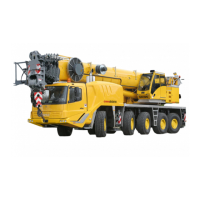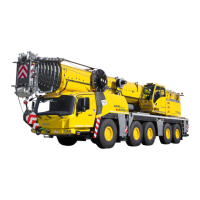Maintenance work on the carrier
7.11 Vehicle brake
7 - 78 3 302 364 en Maintenance manual
GMK 4100L-1
25.11.2016
Checking the surface
• Check for signs of damage such as cracks
and irregularities:
(A) – fine network of cracks,
(B) – radial cracks,
(C) – circular irregularities,
(D) – continuous cracks.
• Check that any damage found lies within the
permissible limit values.
You must have the brake disc replaced if any
limit values are exceeded;
à Having the brakes
repaired
, p. 7 - 81.
Limit values for damage:
(A) – permissible,
(B) –
only pe
rmissible for a crack length up to three-quarters of the length Y.
(B) – only permissible for a crack width of up to 0.5 mm (0.02 in).
(C) – only permissible for a crack depth of up to 1.5 mm (0.06 in).
(D) – not permissible.
Measure the runout
• Attach the dial gauge (1) to the brake anchor
plate (2).
• Position the measuring probe (3)
perpendicular to the brake disc (4).
The distance (A) to the edge of the brake
disc must be 35 mm (1.38 in).
• Rotate the brake disc one full revolution and
read the runout on the dial gauge pointer.
You must have the brake disc replaced if the
runout is greater than 0.15 mm (0.006 in);
à Having the brakes repaired, p. 7 - 81.
